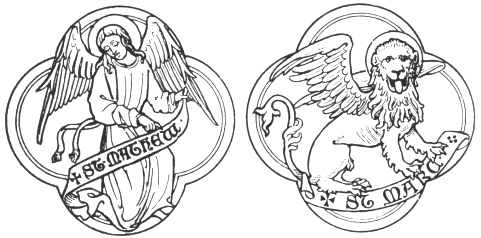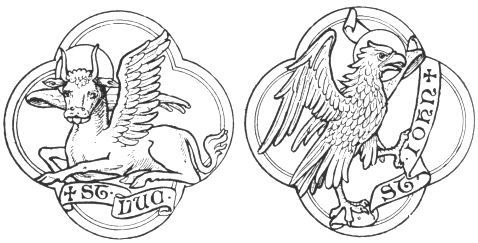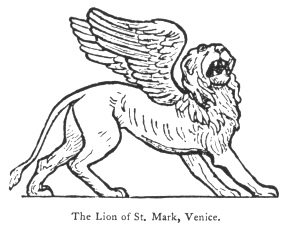
Masonic, Occult and Esoteric Online Library
Fictitious and Symbolic Creatures in Art
By John Vinycomb
Celestial Beings - Emblems of the Four Evangelists
The winged living figures, symbols of the evangelists, which are most frequently met with, and which have ever been most in favour with Early Christian artists, appear to have been used at a very early date. They are taken from the vision of Ezekiel and the Revelation of St. John. "The writings of St. Jerome," says Audsley, "in the beginning of the fifth century gave to artists authority for the appropriation of the four creatures to the evangelists," and for reasons which are there given at length.
St. Matthew: Winged Man, Incarnation.—To St. Matthew was given the creature in human likeness, because he commences his gospel with the human generation of Christ, and because in his writings the human nature of Our Lord is more dwelt upon than the divine.
St. Mark: Winged Lion, The Resurrection.—The Lion was the symbol of St. Mark, who opens his gospel with the mission of John the Baptist, "the voice of one crying in the wilderness." He also sets forth the royal dignity of Christ and dwells upon His power manifested in the resurrection from the dead. The lion was accepted in early times as a symbol of

the resurrection because the young lion was believed always to be born dead, but was awakened to vitality by the breath, the tongue, and roaring of its sire.

St. Luke: Winged Ox, Passion.—The form of the ox, the beast of sacrifice, fitly sets forth the sacred office, and also the atonement for sin by blood, on which, in his gospel, he particularly dwells.
St. John: The Eagle, Ascension.—The eagle was allotted to St. John because, as the eagle soars towards heaven, he soared in spirit upwards to the heaven of heavens to bring back to earth revelation of sublime and awful mysteries.
Independently of their reference to the four evangelists these figures sometimes refer to the Incarnation, the Passion, the Resurrection, and the Ascension.
Sedulius, a priest and poet of the fifth century, says much the same in the following verse:
Hoc Matthæus agens, Hominem generaliter implet:
Marcus ut alta fremit vox per deserta Leonis:
Jura sacerdotis Lucas tenet ore Jubenci:
More volens Aquilæ verbo petit Johannes.
The Lion of St. Mark.—In the ninth century the rapidly rising State of Venice was dignified by the reception of the relics of St. Mark, transported thither from Alexandria. "Few patron saints," says Theodore A. Buckley, "enjoy a greater popularity, whether socially or locally exemplified. His lion was emblazoned on the standard of the Republic, and stamped on the current coins, while his name was identified with the pride, the power, and glory of all Venice." *
Emblems of the evangelists do not often appear in heraldry.
Walter Reynolds, Archbishop of Canterbury, according to a manuscript at Lambeth (executed for Archbishop Laud), bore azure on a cross or, between the symbols of the evangelists of the last, four lions rampant gules.
The Freemasons appear to use a similar coat of arms upon their seal, viz., a cross between the emblems of the four evangelists, and for supporters two cherubims, all proper.

